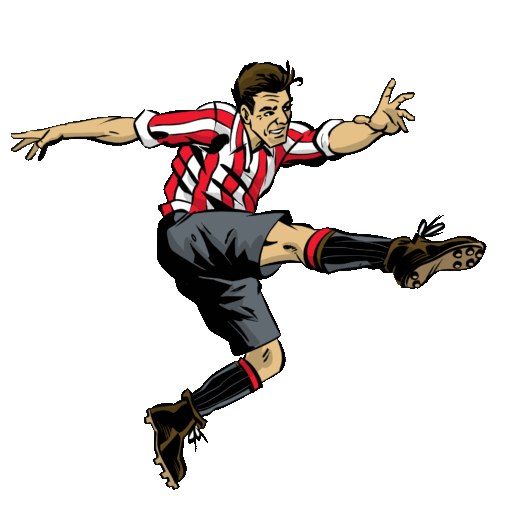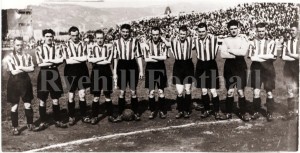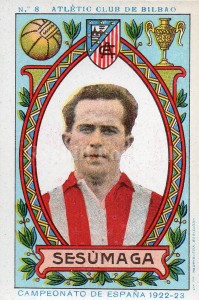The Sunderland team lineup before the game with Athletic Bilbao on 13 May 1934, the first on a 3 match end of season Spanish tour. The game ended 3 v 3.
Davis, Thomson, Johnson, McNab, Hastings, Gurney, W Murray, Shaw, Middleton, Gallacher, Connor
Watch a live Ahtletic Bilbao La Liga game on say Sky Television and the chances are that at some point the commentator will tell you that the Basque team wear their red and white stripes (rojiblancos), black shorts and black socks in homage to Sunderland AFC, or most definitively Arthur Pentland a British migrant worker from the North East of England who was a founding member of the club.
The questions posed over the years is “who was Arthur Pentland and how come Athletic wear red and white stripes”.
To assist with answering the above questions we must first look at the origins of Athletic Bilbao.
Athletic Bilbao
Football was introduced to Bilbao by two distinct groups of players, both with British connections. In the late 1800s Bilbao was a leading port at the heart of an important industrial area with iron mines and shipyards nearby. It was the driving force of the Spanish economy and as a result attracted many migrant workers. Among them were miners from the north-east of England, including Sunderland, and shipyard workers from Southampton and Portsmouth. In the early 1890s these workers came together and formed Bilbao Football Club.
Meanwhile, sons of the Basque educated classes had made the opposite journey and went to Britain to complete their studies in civil engineering and commerce. While in Britain these students developed an interest in football and on their return to Bilbao they began to arrange games with British workers. In 1898 students belonging to the Gymnasium Zamacois founded the Athletic Club, deliberately using the English spelling. In 1901 a meeting was held in the Cafe Garcia which established more formal rules and regulations.
In 1902 the two Bilbao clubs entered a combined team, known as Club Vizcaya , in the first Copa del Rey. They returned with the trophy after defeating FC Barcelona in the final. This would lead to the eventual merger of the two clubs as Athletic Club de Bilbao in 1903. In the same year Basque students also formed Athletic Club de Madrid. This club later evolved into Atlético Madrid. The club’s foundation date is a subject of debate among football historians. The club itself declares 1898, but others claim 1901 is the true founding year.
Equally debated, is the origin of the club colours. Although their first colours were blue and white stripes, in 1910 they switched to red and white stripes for the Vizcaya cup match against Sporting Irun on 9 January. There are three schools of thought about why this occurred. The most common theory is that they were changed out of deference to Sunderland and Southampton. Another is that an Athletic member was sent to Britain to buy a batch of blue and white tops but could not find any and returned with red and white tops instead.
Perhaps the most credible theory, however, is that red and white striped tops were the cheapest stripes to make because the same combination was used to make bed mattresses. The left over cloth was easily converted into football shirts. Although both Athletic Bilbao and Atletico Madrid started out with blue and white stripes, the discovery of a cheaper option probably persuaded them to change. The Madrid club did it first and they became known as Los Colchoneros – the mattress makers.
There is a final version but not commonly referred to. The Basque flag is known as The Irukkina and was created in 1894 by Sabino Arana (the founder of Basque Nationalism). The red in the flag represented the blood shed by the Basques in defence of their land and the white represented God/the Catholic Church.
Felix Sesumaga, Athletic Bilbao, 1922/23
What of Arthur Pentland?
There is no known record of this man either from or in Sunderland and indeed even if he was a founder of the Bilbao club the fact that they changed to red and white stripes in 1910 lends to a theory that he had nothing to do with the switch as the foundation and the strip change came years after each other. Far more plausible is that there is a mix up here with Fred Pentland who was the revered English manager of Athletic Bilbao in two spells between 1922 to 1933. However Fred Pentland was from Wolverhampton, not Sunderland and has no known connections to the North East.
On 1 February 1941 General Franco, the Spanish dictator forced the Basques to change the football clubs name to Athletico Bilbao. However by 1942/43 the club had effectively ignored this dictat and were back to calling themselves by the Anglocised Athletic. As if to emphasise the connection between The Basques and England many volunteers from America, Ireland and Britain fought alongside the Basques in defence of the Spanish Republic against Franco’s Nationalists. Indeed they formed what was known as the Fifteenth International Brigade.
The animosity between the people’s of the Republic and the Nationalists from Madrid remains to this day. Also remaining is the Basques love of the English as borne out by England being based in Bilbao for the 1982 World Cup. Although fiercely partisan the Basques and Bilbao in particular is known as a very friendly welcoming place and has taken on a sophisticated mode with culture being personified in the Guggenhiem Museum that dominates part of the Bilbao skyline.
Around 1999 I was asked by then Commercial Director for Sunderland AFC, Jim Slater, to advise on the links between Sunderland AFC and Athletic Bilbao. Unfortunately I could find none. One reason for being contacted was that an official approach from Sunderland AFC had left the Bilbao Club’s Directors non plussed as to their links with our famous red and white stripes. In short they’d never heard of the story!
It would great if there was a connection but as it stands there is no connection between Sunderland AFC’s red and white stripes and that of Bilbao, no historical evidence to support an Arthur Pentland influencing the famous strip of both teams and the most plausible explanation for the strips of both Bilbao and Athletico Madrid is due to the Mattress Makers or a link with Southampton FC (see postscript below).
Nice story though…..
Postscript:
As a postscript to this story Southampton FC have a write up on their relationship with Bilbao







